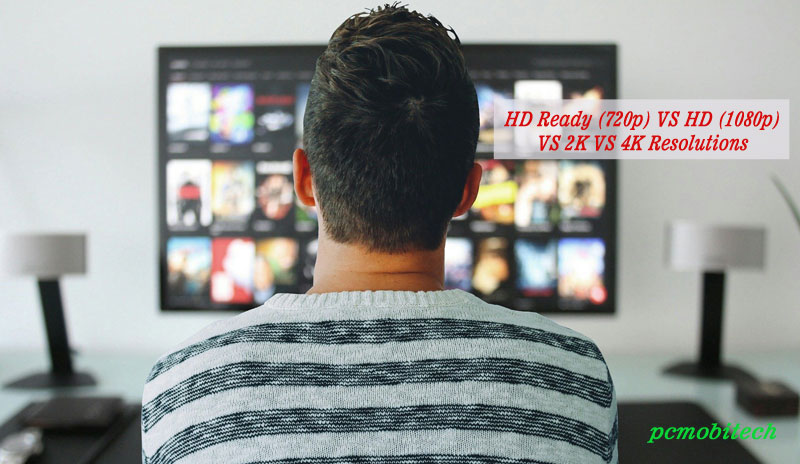While shopping a television set, one of the first things (read: words) that you will come across, is resolution, just after you are done judging the set based on its price and the size of its screen.
Do not get lost in the myriad of thoughts as to what this might mean. We are here to help you out. A few decades ago, the display resolution or the screen resolution was not a discussion subject when it came to buying computer screens or television sets.

However, times have changed, and technology has solely played a role in changing time. With numerous options, we are in the midst of a sea of confusion. In this article, you will get to know the difference between HD Ready (720P), HD (1080p), 2k (1080P), and 4k (2160P).
Quick Links
Let’s start with a few questions and answers clearing the air about the resolution-
1. What is the resolution?
No, it is not the total number of pixels; rather it is the number of pixels per unit area. Resolutions, roughly, mean the fraction of pixels organized vertically as well as horizontally upon the monitor.
2. What is UHD?
It is a short abbreviation for Ultra High Definition. You might call it 4k- quite simple.
3. What is 4K?
Generally 3,840×2, 160 pixels
4. Are most television sets 4K?
Mostly, at 50 inches and above
5. 4K is four times greater than 1080p, so 4K generally is 4320p, right?
No
More on Resolution Concepts
Before knowing what resolutions are, one must have a clear idea about the pixels.
Pixels are the building blocks or the rock basis of every display. These are millions of tiny dots that make up for a perfect and complete picture that we see.
Earlier, the availability of choices depended entirely on the capability of video cards which again was dependent on the manufacturer.
The Windows’ resolutions were mostly limited, and if you did not have a driver for your video card, you could not move ahead of the lower resolution screen, no matter what. With time, however, it has tremendously changed and has been modified.
The p and I (720p, 1080i) respectively stand for progressive plus interlaced.
This interlaced scan was majorly a characteristic feature of television and old CRT Monitors. With the advancement of technology from refresh rate to frame rate, the system has changed from interlaced scan to progressive scan. It is mainly because the digital displays are faster than ever.
Nevertheless, the frame rate refers to the speed with which the monitor displays each frame (of data).
The resolutions on flat TV are much more in number (uncountable) than the older TVs. Old TVs or 32-inch models have more than a million pixels (720p). The larger TVs (not more than 49 inches) have more than 2 million pixels (1080p).
TVs more than 50 inches have 8 million pixels (4K UHD). The most expensive TVs, which are also the largest, have more than 33 million pixels (8K).
These pixels are not visible to the eyes, unless and until you examine the screen with a magnifying glass; even that doesn’t guarantee you will be able to see these.
| Resolutions | Pixels (horizontal x vertical) | Devices |
| 8K (8K UHD) | 7,680×4320 | Televisions |
| UHD (4K) | 3,840×2,160 | Television, Monitor |
| 2K | 2,048x (?) | Projectors |
| 1,080p (Full HD, High Definition) | 1,920 x1,080 | Television, Monitor |
| 720p (HD, High Definition) | 1,280×720 | Television |
Types of Resolutions
1) 4K UHD
It is the most common resolution for new age televisions. If it is solely based on TVs, 4K and Ultra HD are the same. TVs with Ultra HD Blu-ray and UHD streaming content from Amazon, Netflix comes into this category. However, the meaning of 4K completely changes when it comes to a projector in a theatre.
Digital Cinema Initiatives set forth the 4K (horizontal) resolution of 4,096 pixels. Since the aspect ratio varies from one movie to another, no vertical resolution has been specified. However, Sony’s home 4K projectors are accurate to the actual 4K.
In most computers, most video cards which are also the latest can render games at 4K!
2) 8K UHD
Just like 4K, if it is just based on television, 8K is two times higher than the vertical and horizontal 4K resolutions.
Although the newest and most expensive TVs in the market are generally on a rise, these are still not the most common resolution.
Mainly because these have not yet evolved from the experimental stage and also these are the most expensive.
3) 2K
Before 4K hit the market and accounted for most sell, 2K resolutions despite their existence did not even matter and were not worth a discussion.
Most digital cinema projectors in theatres are 2K resolution. The 2K (horizontal) resolution is 2,048 pixels. 2K is often used as a shorthand for 1080p resolutions in HDTVs and Blu-ray.
4) 1080p (Full HD)
Unlike theatre projectors, TVs have mostly used vertical pixels. 1080p is the vertical resolution. 1080i and 1080p are just similar.
Most broadcasts from CBS and NBC are 1080i.
5) 720p HD
It is half the number of pixels in 1080p resolutions. The era of 720p resolutions has long gone. However, ABC, ESPN, Fox, and all their affiliated channels still make use of 720p. Crazy!
Basic Differences amongst different resolutions
- The higher the number of pixels, the better quality visual representation is available. In that case, 4K and 8K resolutions are preferred to 1080p and 720p. 720p resolution is almost on the verge of extinction!
- 4K and 8K resolutions look much better because of smooth and fine lines, curves, textures, and detail. You will love it if you know your favorite actor has a tiny birth spot/legion on their chin.
- With higher resolution screens, you do not have to see the pixels, no matter how close you are to the screen. 4K and 8K to the win!
- 4K is more common than 8K because it is comparatively cheaper and cost worthy and because 8K has not evolved from its experimental stage.
Final Thoughts!
With the advancement of technological inventions, shortly, we might just be introduced to 10K resolutions as well.
However, do not worry if you chose to have a 4K resolution, 65-inch Ultra HD flat television because it will not get outdated in at least a decade. The 8K has a long way to go before flooding the market.
However, if you are still stuck with your 32-inch old model, it is high time you should upgrade it to a larger, better 4k resolution.
When you purchase through links on our site, we may earn an affiliate commission. Read our Affiliate Policy.




